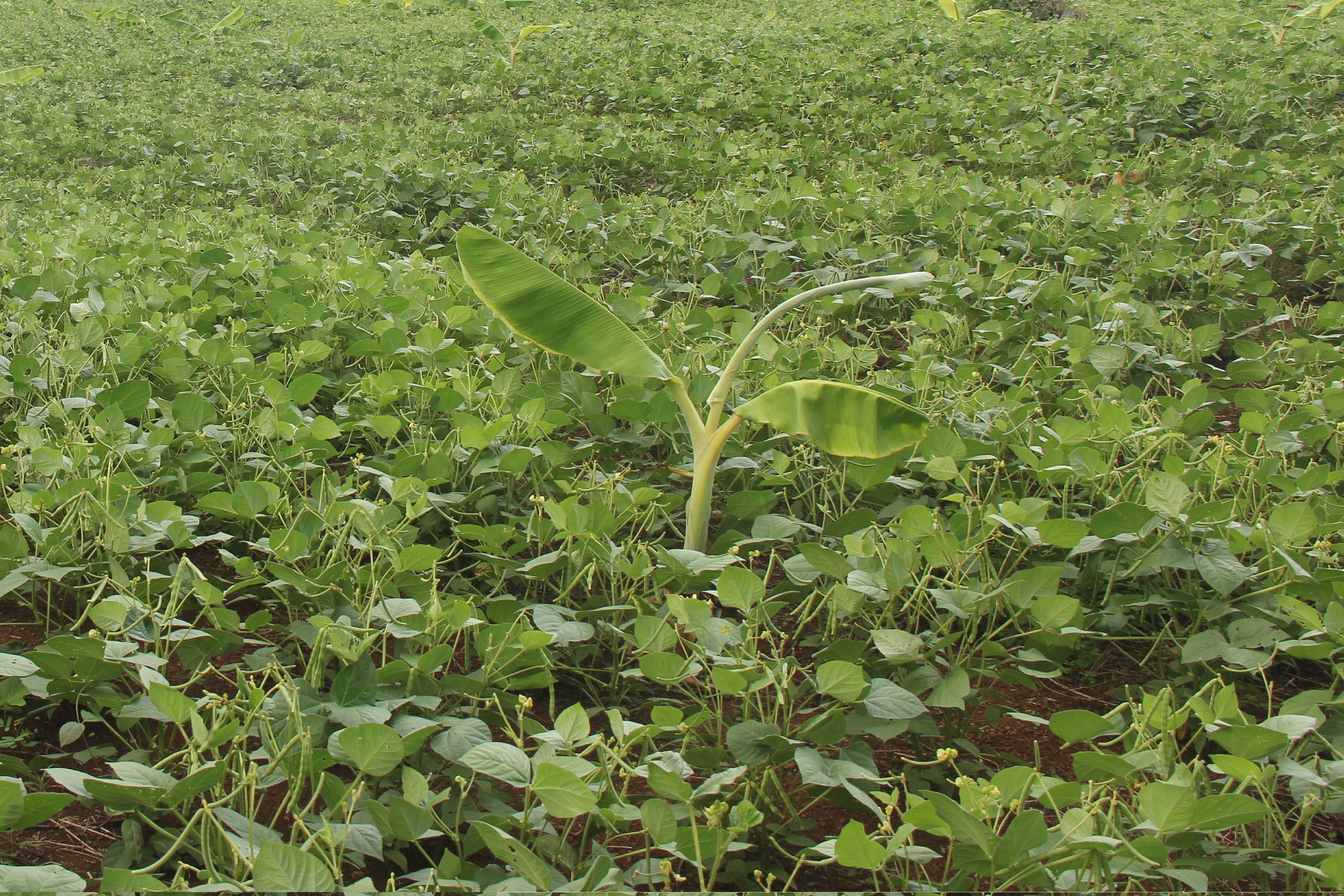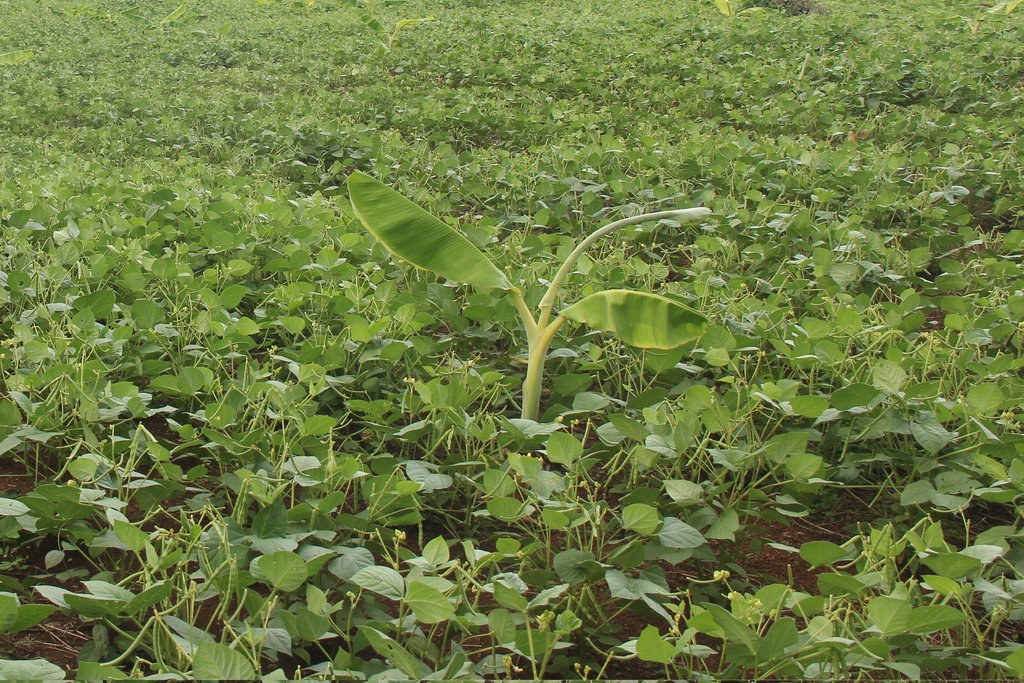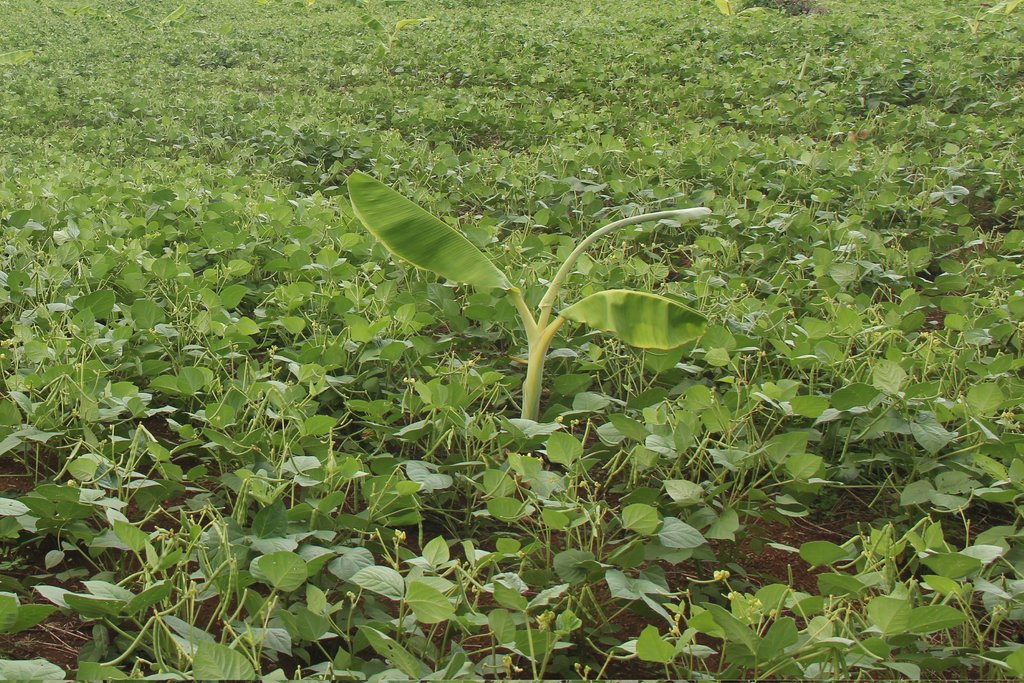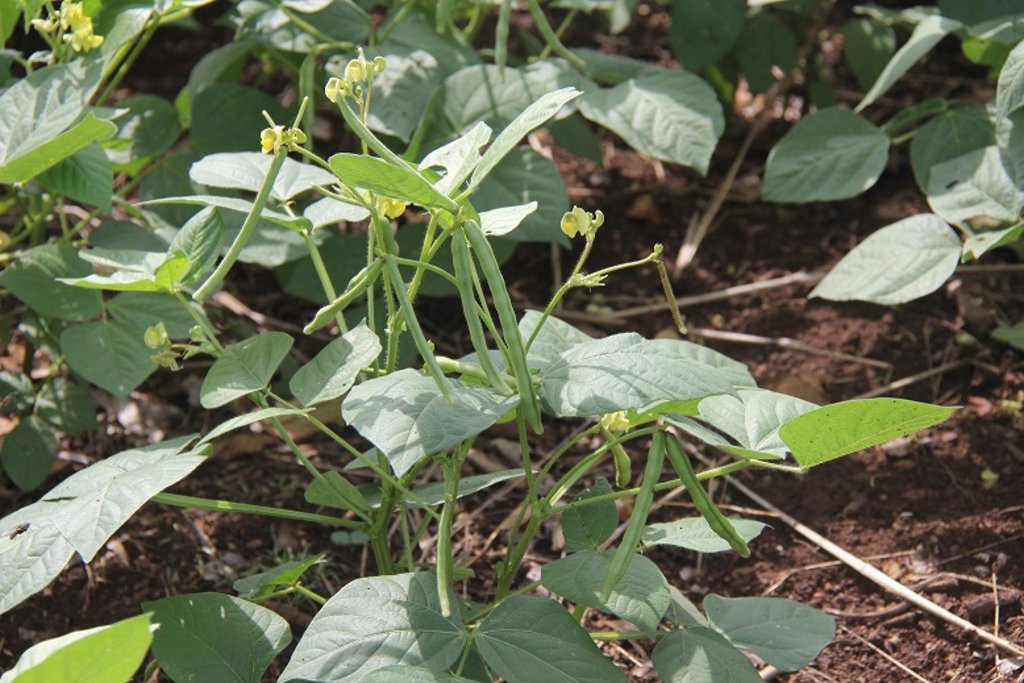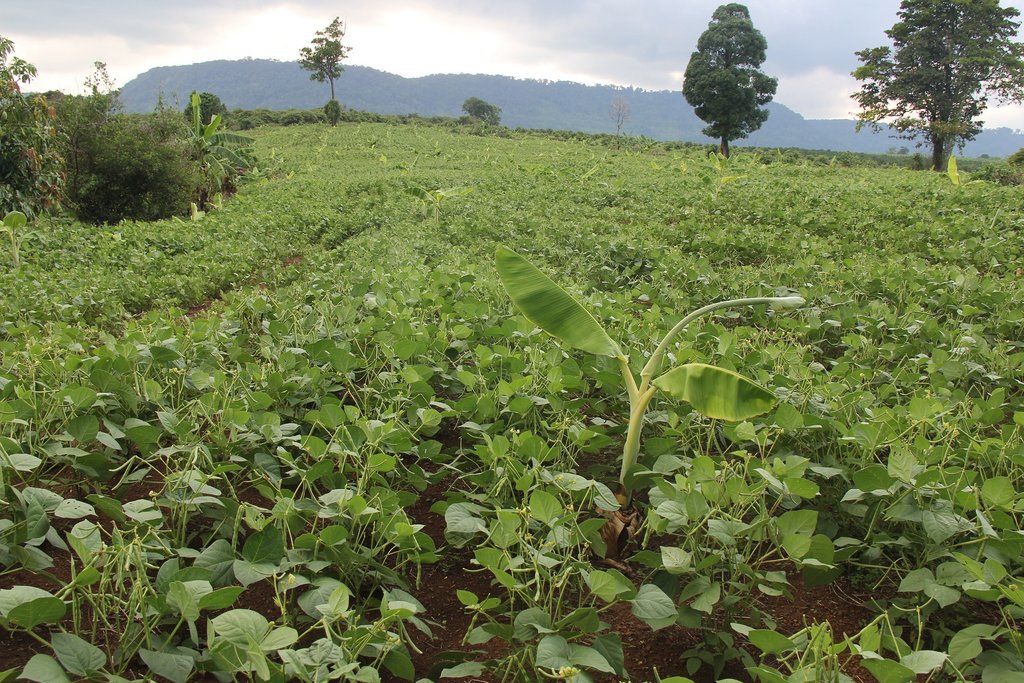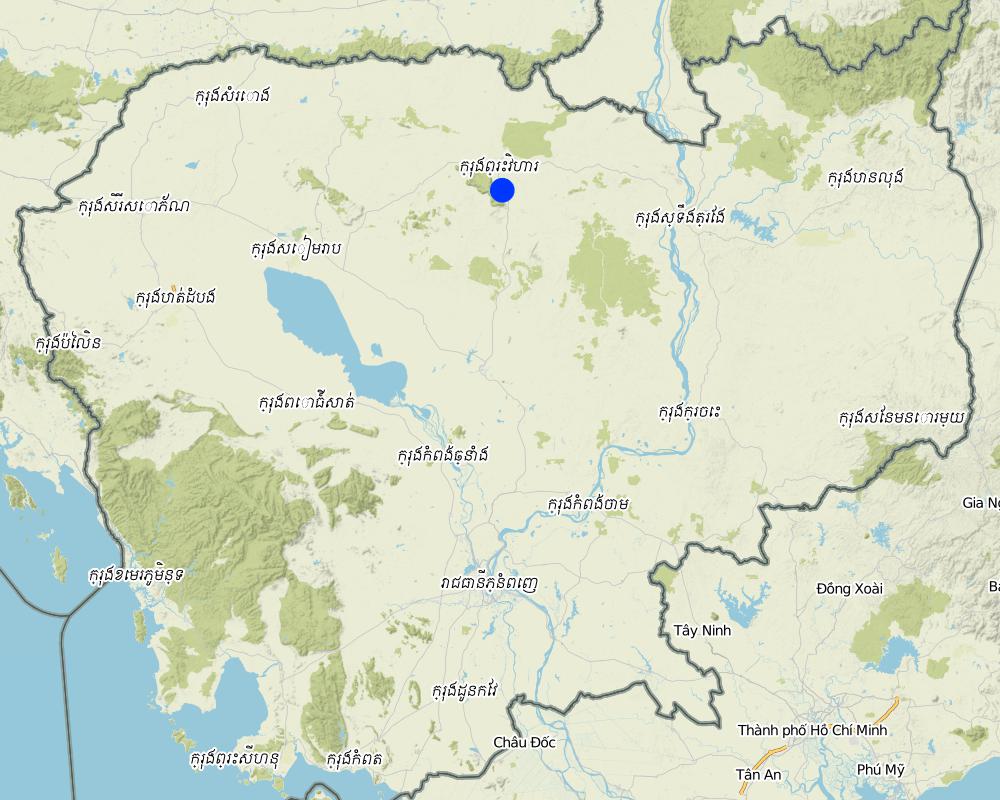Intercropping of mung bean and banana in the uplands [Cambodia]
- Creation:
- Update:
- Compiler: SOEM DA
- Editors: Sophea Tim, Navin Chea, Sok Pheak
- Reviewers: Nimul CHUN, Stephanie Jaquet, Nicole Harari, Ursula Gaemperli, Alexandra Gavilano
Growing mug bean with banana
technologies_1890 - Cambodia
View sections
Expand all Collapse all1. General information
1.2 Contact details of resource persons and institutions involved in the assessment and documentation of the Technology
Key resource person(s)
land user:
Mun Sophea
Farmer
Cambodia
Chief of Agricultural Office of Kuleaen District:
Official of Agricultural Office of Choam Khsant District:
Prachnha Chlat
Agricultural Office of Choam Khsant District
Cambodia
Chief of Agricultural Office of Rovieng District:
Cheng Kuychhun
Agricultural Office of Roveing District
Cambodia
1.3 Conditions regarding the use of data documented through WOCAT
The compiler and key resource person(s) accept the conditions regarding the use of data documented through WOCAT:
Yes
1.4 Declaration on sustainability of the described Technology
Is the Technology described here problematic with regard to land degradation, so that it cannot be declared a sustainable land management technology?
No
2. Description of the SLM Technology
2.1 Short description of the Technology
Definition of the Technology:
Intercropping of mung beans with bananas adds nutrients to the soil, and generates further income while waiting for the yield of the banana trees.
2.2 Detailed description of the Technology
Description:
The root nodules of mung beans contain rhizobium bacteria that can absorb and store nitrogen from the environment. This is good for any nearby crops, and after the harvest when the field is plowed it improves soil’s nutrient levels (CARDI, 2011). The mung beans residue such as stems, leaves, and shells actively leads to an improvement of the soil’s quality and fertility by increasing the nitrogen level in the soil. Mung beans are mostly grown in March with the seeds being directly placed into pits dug at regular intervals (MAFF, 2005). Bananas are a high-moisture providing crop to the soil, and their root systems add air to the soil and enrich it with humus. Regarding the plantation of banana seedlings, their pits should be 30 cm in depth and should measure 0.5 m x 0.5 m, with a space of 2 meters between each plant (Our Agricultural Market, 2017).
Mrs. Sophea Mun has been living in the upland village known as Andoung Preang, in Preah Khleang commune, Tbaeng Mean Chey district, Preah Vihear province, Cambodia. She was selected for this case study because she has been applying the technique of mung beans intercropped by bananas and thereby contributing to sustainable land management.
One of the reasons for intercropping mung beans between banana trees is to help improve the soil’s fertility by retaining the decomposing residue of the plants in the space between the bananas to act as an organic fertilizer. Moreover, as the cover crop, mung beans also play a role in reducing soil erosion by water and preventing weeds from competing with the growth of the banana trees.
Whilst the technology has beneficial impacts on the soil; it also increases the farmers’ income before the bananas are able to produce a yield. Bananas are the long-term crop and so at the time when they are not yet generating a financial output, the mung beans act as an important source of income to support the farmers’ livelihoods. Banana trees can first be harvested after 10 months and will then produce a higher yield over the second year. The yield will then start to decrease once trees reach the age of six or seven, and once this happens they are cut down. The mung beans are the short-term crop and can be harvested and sold after 3 months and can be grown twice in one season. Generally, when the banana trees are 2 or 3 years old it is not possible to grow mung beans because they provide too much shade and there is not enough sunlight.
The farmer uses about 22 kg of mung bean seeds on a plot of land measuring 70 x 200 meters. The seedlings are planted directly between the banana trees, instead of being broadcast because in this way the seedlings will have enough space between them to allow for ventilation, and ultimately will produce a higher yield. In this case study, the farmer firstly grows mung beans and once these have been harvested will grow soybeans in July and is therefore able to grow twice in one season. Bananas should be planted in rectangular pits measuring 20cm x 30 cm with a depth of 0.5 meters. There should be a space of 4 meters between each of the plants and a distance of 5 meters between the rows. They should be grown in February when there is no rain so that the banana seedlings can flourish. If they are cultivated in the rainy season, they are often vulnerable to mealybugs and do not grow as well as in the dry season.
2.3 Photos of the Technology
2.5 Country/ region/ locations where the Technology has been applied and which are covered by this assessment
Country:
Cambodia
Region/ State/ Province:
Tbaeng Mean Chey district, Preah Vihear province
Further specification of location:
Andoung Preang village, Preah Khleang commune
Specify the spread of the Technology:
- evenly spread over an area
If the Technology is evenly spread over an area, specify area covered (in km2):
0.014
If precise area is not known, indicate approximate area covered:
- < 0.1 km2 (10 ha)
Comments:
Implementation area is 70 x 200 meters =14000 square meters. Renting cost is 1,000,000 Riel per year.
Map
×2.6 Date of implementation
If precise year is not known, indicate approximate date:
- less than 10 years ago (recently)
2.7 Introduction of the Technology
Specify how the Technology was introduced:
- as part of a traditional system (> 50 years)
Comments (type of project, etc.):
Farmer-to-farmers
3. Classification of the SLM Technology
3.1 Main purpose(s) of the Technology
- reduce, prevent, restore land degradation
- create beneficial economic impact
3.2 Current land use type(s) where the Technology is applied

Cropland
- Annual cropping
- Perennial (non-woody) cropping
Annual cropping - Specify crops:
- legumes and pulses - beans
- legumes and pulses - soya
Perennial (non-woody) cropping - Specify crops:
- banana/plantain/abaca
Number of growing seasons per year:
- 2
Specify:
Mung-beans: twice in one season. First banana harvest after 10 month
Is intercropping practiced?
Yes
Comments:
Mung bean/soybean and banana
Livestock density: No animal raising
3.4 Water supply
Water supply for the land on which the Technology is applied:
- rainfed
Comments:
rain-fed cropping
3.5 SLM group to which the Technology belongs
- improved ground/ vegetation cover
3.6 SLM measures comprising the Technology

agronomic measures
- A1: Vegetation/ soil cover
- A2: Organic matter/ soil fertility
- A3: Soil surface treatment
3.7 Main types of land degradation addressed by the Technology

soil erosion by water
- Wt: loss of topsoil/ surface erosion

biological degradation
- Bl: loss of soil life
3.8 Prevention, reduction, or restoration of land degradation
Specify the goal of the Technology with regard to land degradation:
- prevent land degradation
Comments:
High crop production without loss of soil fertility
4. Technical specifications, implementation activities, inputs, and costs
4.1 Technical drawing of the Technology
Technical specifications (related to technical drawing):
The farmers intercrop mung beans with bananas on the same plot (70m x 200m=14000 square meters and slope of 30-degree). The space between each row of bananas is 5 meters and space between each banana plant is 4 meters, amounting to a total of 600 banana trees. The mung beans can be directly planted in a row between the banana trees by placing two or three seeds in one hole with a depth of 3 to 4 cm. On this piece of land the farmer planted 22 kg of mung bean seeds.
Author:
Mr. Khuon Sophal
Date:
05/05/2017
4.2 General information regarding the calculation of inputs and costs
Specify how costs and inputs were calculated:
- per Technology area
Indicate size and area unit:
70 X 200= 14000 square meters
other/ national currency (specify):
Riel
If relevant, indicate exchange rate from USD to local currency (e.g. 1 USD = 79.9 Brazilian Real): 1 USD =:
4000.0
Indicate average wage cost of hired labour per day:
20000 Riel
4.3 Establishment activities
| Activity | Timing (season) | |
|---|---|---|
| 1. | Pick out the cassava stem | When starting grow mung bean |
| 2. | Ploughing and drying the soil | January |
| 3. | Buying the banana tree seedlings | February |
| 4. | Digging the holes for the banana seedlings and planting | March |
| 5. | Buying mung bean seed | March |
| 6. | Buy hoe | March |
4.4 Costs and inputs needed for establishment
| Specify input | Unit | Quantity | Costs per Unit | Total costs per input | % of costs borne by land users | |
|---|---|---|---|---|---|---|
| Labour | Ploughing and drying the soil | person-day | 3.6 | 20000.0 | 72000.0 | 100.0 |
| Labour | Digging the hole for the banana seedlings and planting | person-day | 1.5 | 20000.0 | 30000.0 | 100.0 |
| Equipment | Hooked knife | piece | 5.0 | 25000.0 | 125000.0 | 100.0 |
| Equipment | Hoe | piece | 3.0 | 20000.0 | 60000.0 | 100.0 |
| Plant material | Banana seedlings | seedling | 600.0 | 300.0 | 180000.0 | 100.0 |
| Total costs for establishment of the Technology | 467000.0 | |||||
| Total costs for establishment of the Technology in USD | 116.75 | |||||
4.5 Maintenance/ recurrent activities
| Activity | Timing/ frequency | |
|---|---|---|
| 1. | Soil preparation and direct seedling of mung beans | March |
| 2. | Spray the herbicide | 20 days after mung bean sowing |
| 3. | Weeding | Every month |
| 4. | Spray the fattening fertilizer | After first harvesting |
4.6 Costs and inputs needed for maintenance/ recurrent activities (per year)
| Specify input | Unit | Quantity | Costs per Unit | Total costs per input | % of costs borne by land users | |
|---|---|---|---|---|---|---|
| Labour | Soil preparation and direct seedling of mung beans | person-day | 2.0 | 20000.0 | 40000.0 | 100.0 |
| Labour | Spray the herbicide and weeding | person-day | 10.0 | 20000.0 | 200000.0 | 100.0 |
| Labour | Spray the fattening fertilizer | person-day | 1.0 | 20000.0 | 20000.0 | 100.0 |
| Labour | Harvesting | person-day | 12.0 | 20000.0 | 240000.0 | 100.0 |
| Plant material | Mung bean | kg | 24.0 | 12000.0 | 288000.0 | 100.0 |
| Fertilizers and biocides | Herbicide | liter | 2.0 | 12000.0 | 24000.0 | 100.0 |
| Fertilizers and biocides | Fattening fertilizer | liter | 2.0 | 11000.0 | 22000.0 | 100.0 |
| Total costs for maintenance of the Technology | 834000.0 | |||||
| Total costs for maintenance of the Technology in USD | 208.5 | |||||
4.7 Most important factors affecting the costs
Describe the most determinate factors affecting the costs:
Buying seeds and hiring labor for digging the holes
5. Natural and human environment
5.1 Climate
Annual rainfall
- < 250 mm
- 251-500 mm
- 501-750 mm
- 751-1,000 mm
- 1,001-1,500 mm
- 1,501-2,000 mm
- 2,001-3,000 mm
- 3,001-4,000 mm
- > 4,000 mm
Specify average annual rainfall (if known), in mm:
1429.30
Specifications/ comments on rainfall:
The annual rainfall in 2015 is 1429.3 mm. In 2014 is 1647.3 mm.
Indicate the name of the reference meteorological station considered:
Ministry of water resources and meteorology (2015)
Agro-climatic zone
- sub-humid
There are 2 seasons, dry season and rainy season.
5.2 Topography
Slopes on average:
- flat (0-2%)
- gentle (3-5%)
- moderate (6-10%)
- rolling (11-15%)
- hilly (16-30%)
- steep (31-60%)
- very steep (>60%)
Landforms:
- plateau/plains
- ridges
- mountain slopes
- hill slopes
- footslopes
- valley floors
Altitudinal zone:
- 0-100 m a.s.l.
- 101-500 m a.s.l.
- 501-1,000 m a.s.l.
- 1,001-1,500 m a.s.l.
- 1,501-2,000 m a.s.l.
- 2,001-2,500 m a.s.l.
- 2,501-3,000 m a.s.l.
- 3,001-4,000 m a.s.l.
- > 4,000 m a.s.l.
Indicate if the Technology is specifically applied in:
- convex situations
5.3 Soils
Soil depth on average:
- very shallow (0-20 cm)
- shallow (21-50 cm)
- moderately deep (51-80 cm)
- deep (81-120 cm)
- very deep (> 120 cm)
Soil texture (topsoil):
- medium (loamy, silty)
Soil texture (> 20 cm below surface):
- medium (loamy, silty)
Topsoil organic matter:
- medium (1-3%)
If available, attach full soil description or specify the available information, e.g. soil type, soil PH/ acidity, Cation Exchange Capacity, nitrogen, salinity etc.
pH = 6.2
5.4 Water availability and quality
Ground water table:
5-50 m
Availability of surface water:
medium
Water quality (untreated):
for agricultural use only (irrigation)
Is water salinity a problem?
No
Is flooding of the area occurring?
No
5.5 Biodiversity
Species diversity:
- medium
Habitat diversity:
- medium
5.6 Characteristics of land users applying the Technology
Sedentary or nomadic:
- Sedentary
Market orientation of production system:
- commercial/ market
Off-farm income:
- 10-50% of all income
Relative level of wealth:
- poor
Individuals or groups:
- individual/ household
Level of mechanization:
- manual work
- mechanized/ motorized
Gender:
- women
Age of land users:
- middle-aged
Indicate other relevant characteristics of the land users:
Farmer is 31 years old.
5.7 Average area of land used by land users applying the Technology
- < 0.5 ha
- 0.5-1 ha
- 1-2 ha
- 2-5 ha
- 5-15 ha
- 15-50 ha
- 50-100 ha
- 100-500 ha
- 500-1,000 ha
- 1,000-10,000 ha
- > 10,000 ha
Is this considered small-, medium- or large-scale (referring to local context)?
- small-scale
Comments:
Land size 70 x 200 m
5.8 Land ownership, land use rights, and water use rights
Land ownership:
- individual, titled
- ជួលគេ
Land use rights:
- leased
- rain-fed
5.9 Access to services and infrastructure
health:
- poor
- moderate
- good
education:
- poor
- moderate
- good
technical assistance:
- poor
- moderate
- good
employment (e.g. off-farm):
- poor
- moderate
- good
markets:
- poor
- moderate
- good
energy:
- poor
- moderate
- good
roads and transport:
- poor
- moderate
- good
drinking water and sanitation:
- poor
- moderate
- good
financial services:
- poor
- moderate
- good
6. Impacts and concluding statements
6.1 On-site impacts the Technology has shown
Socio-economic impacts
Production
crop production
Comments/ specify:
Continuous harvest of long-term and short-term crops
crop quality
Comments/ specify:
Use less of chemical fertilizer and shifting crops.
risk of production failure
Comments/ specify:
Insect invasion has been reduced.
product diversity
Comments/ specify:
As banana and mung beans are cultivated, the product diversity increased
land management
Comments/ specify:
Mung beans and soybeans help to improve soil fertility especially regarding nitrogen, and thus, less chemical fertilizing is needed. Further, the soil cover by the beans between the banana plants prevents weeding.
Income and costs
expenses on agricultural inputs
Comments/ specify:
Farmers spend more money for wage labor.
farm income
Comments/ specify:
Before, the farmer cultivated cassava which he harvested only once a year. But now, she cultivates banana with bean that can be harvested twice a year until the banana is able to produce yield.
diversity of income sources
Comments/ specify:
Now, income is generated from both from mung beans (or soybeans) and banana.
Socio-cultural impacts
food security/ self-sufficiency
Comments/ specify:
It is improved due to the cultivation of more then only one crop (banana and mung beans or soybeans).
SLM/ land degradation knowledge
Comments/ specify:
The farmer learned from this cultivation method, (Mung beans or soybeans between banana trees) that soil erosion can be reduced and soil fertility can be improved.
Ecological impacts
Soil
soil moisture
Comments/ specify:
Banana cultivation with mung beans or soybeans improved the soil moisture due to better soil cover (less soil evaporation).
soil cover
Comments/ specify:
Due to the Mung beans or soybeans plants between banana trees, the soil cover is improved.
soil loss
Comments/ specify:
Due to annual crops cover.
soil organic matter/ below ground C
Comments/ specify:
Enrichment of nitrogen due to the bean cultivation, due to nitrogen-fixing Bacterium in their roots.
Biodiversity: vegetation, animals
Vegetation cover
Comments/ specify:
Due to the mung beans or soybeans plants between banana trees, the vegetation cover has been improved. Mung beans or soybeans help to prevent soil erosion and keep the soil moisture.
beneficial species
Comments/ specify:
Increase e.g. of mole cricket and earth worms
6.2 Off-site impacts the Technology has shown
Specify assessment of off-site impacts (measurements):
No off-site impacts
6.3 Exposure and sensitivity of the Technology to gradual climate change and climate-related extremes/ disasters (as perceived by land users)
Gradual climate change
Gradual climate change
| Season | increase or decrease | How does the Technology cope with it? | |
|---|---|---|---|
| annual temperature | increase | not known | |
| seasonal temperature | wet/ rainy season | increase | not known |
6.4 Cost-benefit analysis
How do the benefits compare with the establishment costs (from land users’ perspective)?
Short-term returns:
positive
Long-term returns:
positive
How do the benefits compare with the maintenance/ recurrent costs (from land users' perspective)?
Short-term returns:
positive
Long-term returns:
positive
6.5 Adoption of the Technology
- 11-50%
If available, quantify (no. of households and/ or area covered):
Several housholds (the exact amount is not known)
Of all those who have adopted the Technology, how many did so spontaneously, i.e. without receiving any material incentives/ payments?
- 91-100%
6.6 Adaptation
Has the Technology been modified recently to adapt to changing conditions?
No
6.7 Strengths/ advantages/ opportunities of the Technology
| Strengths/ advantages/ opportunities in the land user’s view |
|---|
| Optimal land use of a given plot, providing the opportunity to plant two crops. |
| Generate an income from the short term crop before the long term crop provides a yield. |
| Prevents grass from growing because it is not given the opportunity with the crop growing on the land instead. |
| Strengths/ advantages/ opportunities in the compiler’s or other key resource person’s view |
|---|
| Mung beans are a short-term crop which also add supplementary nutrients to the soil. |
| A reduction in soil erosion because of the natural crop cover. |
| Provides an income for households whilst the bananas have not yet produced a yield. |
6.8 Weaknesses/ disadvantages/ risks of the Technology and ways of overcoming them
| Weaknesses/ disadvantages/ risks in the land user’s view | How can they be overcome? |
|---|---|
| Appearance of worms. | Application of pesticides according to standardized practices. |
| Lack of a water source for irrigation. | Depends on the rainfall |
7. References and links
7.1 Methods/ sources of information
- field visits, field surveys
A place
- interviews with land users
A person
- interviews with SLM specialists/ experts
3 people
When were the data compiled (in the field)?
05/05/2017
7.2 References to available publications
Title, author, year, ISBN:
CARDI (2011) Growing mungbean on sandy soil after harvesting wet season rice. Farmer Nowslette.(In Khmer Language)Retrieve on May 03, 2018,from
Available from where? Costs?
http://www.maff.gov.kh/agri-tech/56%E1%9E%8A%E1%9F%86%E1%9E%8E%E1%9E%B6%E1%9F%86%E1%9E%A7%E1%9E%9F%E1%9F%92%E1%9E%9F%E1%9E%B6%E1%9E%A0%E1%9E%80%E1%9E%98%E1%9F%92%E1%9E%98/%E1%9E%80%E1%9E%B6%E1%9E%9A%E1%9E%8A%E1%9E%B6%E1%9F%86%E1%9E%8A%E1%9E%BB%E1%9F%87%E1%9E%9F%E1%9E%8E%E1%9F%92%E1%9E%8F%E1%9F%82%E1%9E%80/961-bean-after-rainy-harvest.html
Title, author, year, ISBN:
MAFF(2005) Mungbean. (In Khmer language) Retrieve on May 03, 2018, from
Available from where? Costs?
https://docs.google.com/file/d/0B3kkBprEzhDobllqbnFrVmVGTGM/view
7.3 Links to relevant online information
Title/ description:
Our Agricultural Market(2017) Good techniques for farmers who want to grow banana to generate income.(In Khmer language)Retrieve on May 03, 2018, from
URL:
https://www.e-oam.com/?p=3071
Links and modules
Expand all Collapse allLinks
No links
Modules
No modules


